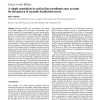Free Online Productivity Tools
i2Speak
i2Symbol
i2OCR
iTex2Img
iWeb2Print
iWeb2Shot
i2Type
iPdf2Split
iPdf2Merge
i2Bopomofo
i2Arabic
i2Style
i2Image
i2PDF
iLatex2Rtf
Sci2ools
BC
2004
2004
A simple translation in cortical log-coordinates may account for the pattern of saccadic localization errors
During saccadic eye movements, the visual world shifts rapidly across the retina. Perceptual continuity is thought to be maintained by active neural mechanisms that compensate for this displacement, bringing the presaccadic scene into a postsaccadic reference frame. Because of this active mechanism, objects appearing briefly around the time of the saccade are perceived at erroneous locations, a phenomenon called perisaccadic mislocalization. The position and direction of localization errors can inform us about the different reference frames involved.Ithasbeenfound,forexample,thaterrorsarenot simply made in the direction of the saccade but directed toward the saccade target, indicating that the compensatory mechanism involves spatial compression rather than translation. A recent study confirmed that localization errors also occur in the direction orthogonal to saccade direction, but only for eccentricities far from the fovea, beyondthesaccadetarget.Thisspatiallyspecificpatternof distort...
| Added | 16 Dec 2010 |
| Updated | 16 Dec 2010 |
| Type | Journal |
| Year | 2004 |
| Where | BC |
| Authors | Rufin van Rullen |
Comments (0)

